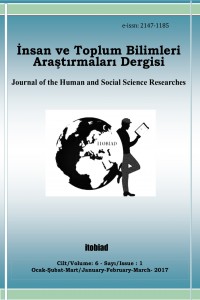Abstract
For students learning English as a foreign language
(EFL), using English outside the classroom is as important as participating in
the classroom activities. By developing the Extramural English Use Scale, this
study aims to explore the frequency of high school students' Extramural English
(EE) in relation to the listening, speaking, reading
and writing skills depending on different variables. 292 students in a
state high school in Turkey were given the 5-point Likert type scale including
34 items, and the data were analyzed using SPSS 22.0. After the reliability and
validity analysis, independent samples t-test, ANOVA and Pearson correlation
analysis were used to reveal whether the frequency of EE use differs depending
on the variables of gender, course selection and perceived English level. It
was found that the frequency of EE use differs depending on these variables. It
was also revealed that the frequency of EE use is low, and thus it is suggested
that students should be encouraged to engage in EE activities.
References
- EF Education First. (2014, 2015, 2016). EF EPI English proficiency index. Retrieved from http://www.ef.com.tr/epi/regions/europe/
- Freed, B. F. (1995). What makes us think that students who study abroad become fluent? In B. F. Freed (ed.), Second language acquisition in a study abroad context (pp. 123-148). Amsterdam: John Benjamins.
- Gao, X. (2006). Strategies Used by Chinese Parents to Support English Language Learning. RELC, 37(3), 285-298.
- Grau, M. (2009). Worlds apart? English in German youth cultures and in educational settings. World Englishes, 28(2), 160-174.
- Hair J. F., Tatham R. L., Anderson R. E. & Black W. (1998). Multivariate Data Analysis, Prentice Hall, New York.
- Hyland, F. (2004). Learning autonomously: contextualizing out-of-class English language learning. Language Awareness, 13(3), 180-202.
- Ibadurrahman, I. (2011). Out-of-class language learning: Case study of Indonesian senior high students in Bandung. Retrieved from: http://www.slideshare.net/IhsanIbadurrahman/lit-review-10281266
- Jourdain, R. (1998). Music, the brain, and ecstasy: How music captures our imagination. New York: Harper Collins.
- Kalaycı, Ş. (2010). SPSS Uygulamalı Çok Değişkenli İstatistik Teknikleri. Asil Yayınları, Ankara.
- Kuppens, A. H. (2010). Incidental foreign language acquisition from media exposure. Learning, Media and Technology, 35 (1), 65–85.
Lise Öğrencilerinin Sınıf Dışı İngilizce Kullanımlarının İncelenmesi: Bir Anket Geliştirme Çalışması
Abstract
Öz
İngilizceyi yabancı dil
olarak öğrenenler için sınıf dışında İngilizceyi kullanmak sınıf içi
etkinliklere katılmak kadar önemlidir. Bu
çalışmanın amacı, Sınıf Dışı İngilizce Kullanma
Ölçeğini geliştirerek lise öğrencilerinin dinleme, konuşma, okuma ve
yazma becerileri ile ilgili sınıf dışı İngilizce kullanım sıklığını farklı
değişkenler açısından incelemektir. Türkiye'deki bir devlet lisesinde eğitim gören
292 öğrenciye 34 maddeden oluşan 5’li Likert tipi bir ölçek verilmiştir ve
veriler SPSS 22.0'de analiz edilmiştir. Ölçeğin geçerlilik ve güvenilirlik
analizi yapıldıktan sonra, sınıf dışı İngilizce etkinliklere katılma sıklığının
cinsiyet, ders seçimi ve algılanan İngilizce seviyesi değişkenlerine göre
farklılık gösterip göstermediğini belirlemek için bağımsız örneklem t testi,
ANOVA ve Pearson korelasyon analizleri kullanılmıştır. Sınıf dışı İngilizce
kullanım sıklığının bu değişkenlere göre farklılık gösterdiği saptanmıştır. Ayrıca,
öğrencilerin sınıf dışı İngilizce kullanım sıklığının düşük olduğu açığa
çıkarılmıştır ve bu nedenle öğrencilerin sınıf dışında İngilizce etkinliklere
katılması teşvik edilmelidir.
References
- EF Education First. (2014, 2015, 2016). EF EPI English proficiency index. Retrieved from http://www.ef.com.tr/epi/regions/europe/
- Freed, B. F. (1995). What makes us think that students who study abroad become fluent? In B. F. Freed (ed.), Second language acquisition in a study abroad context (pp. 123-148). Amsterdam: John Benjamins.
- Gao, X. (2006). Strategies Used by Chinese Parents to Support English Language Learning. RELC, 37(3), 285-298.
- Grau, M. (2009). Worlds apart? English in German youth cultures and in educational settings. World Englishes, 28(2), 160-174.
- Hair J. F., Tatham R. L., Anderson R. E. & Black W. (1998). Multivariate Data Analysis, Prentice Hall, New York.
- Hyland, F. (2004). Learning autonomously: contextualizing out-of-class English language learning. Language Awareness, 13(3), 180-202.
- Ibadurrahman, I. (2011). Out-of-class language learning: Case study of Indonesian senior high students in Bandung. Retrieved from: http://www.slideshare.net/IhsanIbadurrahman/lit-review-10281266
- Jourdain, R. (1998). Music, the brain, and ecstasy: How music captures our imagination. New York: Harper Collins.
- Kalaycı, Ş. (2010). SPSS Uygulamalı Çok Değişkenli İstatistik Teknikleri. Asil Yayınları, Ankara.
- Kuppens, A. H. (2010). Incidental foreign language acquisition from media exposure. Learning, Media and Technology, 35 (1), 65–85.
Details
| Journal Section | Articles |
|---|---|
| Authors | |
| Publication Date | March 30, 2017 |
| Published in Issue | Year 2017 Volume: 6 Issue: 1 |


